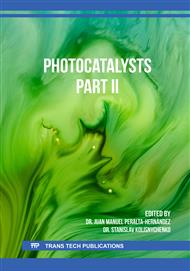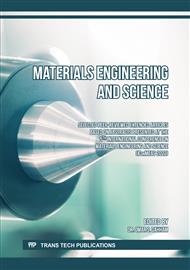[1]
J.H. Li, F. Yan, Q. Zhou, R.P. Ren, L.J. Wu, Y.K. Lv, A regularly combined magnetic 3D hierarchical Fe3O4/BiOBr heterostructure: fabrication, visible-light photocatalytic activity and degradation mechanism, J. Colloid Interface Sci. 546 (2019) 139-151.
DOI: 10.1016/j.jcis.2019.03.028
Google Scholar
[2]
X. Jiang, D.Z. Kong, B.N. Luo, M.T. Wang, D.F. Zhang, X.P. Pu, Preparation of magnetically retrievable flower-like AgBr/BiOBr/NiFe2O4 direct Z-scheme heterojunction photocatalyst with enhanced visible-light photoactivity, Colloids Surf. A: Physicochem. Eng. Asp. 633 (2022) 127880.
DOI: 10.1016/j.colsurfa.2021.127880
Google Scholar
[3]
M. Arumugam, M. Tahir, P. Praserthdam, Effect of nonmetals (B, O, P, and S) doped with porous g-C3N4 for improved electron transfer towards photocatalytic CO2 reduction with water into CH4, Chemosphere 286 (2022) 131765.
DOI: 10.1016/j.chemosphere.2021.131765
Google Scholar
[4]
M. Ismael, M. Wark, Photocatalytic activity of CoFe2O4/g-C3N4 nanocomposite toward degradation of different organic pollutants and their inactivity toward hydrogen production: the role of the conduction band position, Flatchem 32 (2022) 100337.
DOI: 10.1016/j.flatc.2022.100337
Google Scholar
[5]
W.A. Sadik, A.G.M. El-Demerdash, A.W. Nashed, A.A. Mostafa, H.A. Hamad, Highly efficient photocatalytic performance of Cu2O@TiO2 nanocomposite: influence of various inorganic oxidants and inorganic anions, J. Mater. Res. Technol. 8 (2019) 5405-5414.
DOI: 10.1016/j.jmrt.2019.09.007
Google Scholar
[6]
S.D. Yan, Y. Shi, Y.F. Tao, H. Zhang, Enhanced persulfate-mediated photocatalytic oxidation of bisphenol A using bioelectricity and a g-C3N4/Fe2O3 heterojunction, Chem. Eng. J. 359 (2019) 933-943.
DOI: 10.1016/j.cej.2018.11.093
Google Scholar
[7]
L. Yosefi, M. Haghighi, Sequential precipitation design of novel high-efficiency flowerlike BiOBr(x)-Mn3O4(100-x) nanoheterojunction with superior solar-light photo-activity in water treatment, Mater. Res. Bull. 113 (2019) 51-63.
DOI: 10.1016/j.materresbull.2019.01.019
Google Scholar
[8]
S.M. Lam, J.C. Sin, H.H. Zeng, H. Lin, H.X. Li, Y.Y. Chai, M.K. Choong, A.R. Mohamed, Green synthesis of Fe-ZnO nanoparticles with improved sunlight photocatalytic performance for polyethylene film deterioration and bacterial inactivation, Mater. Sci. Semicond. Process. 123 (2021) 105574.
DOI: 10.1016/j.mssp.2020.105574
Google Scholar
[9]
K.H. Ng, C.K. Cheng, A novel photomineralization of POME over UV responsive TiO2 photocatalyst: kinetics of POME degradation and gaseous product formations, RSC Adv. 5 (2015) 53100-53110.
DOI: 10.1039/c5ra06922j
Google Scholar
[10]
Y.W. Cheng, Y.S. Chang, K.H. Ng, T.Y. Wu, C.K. Cheng, Photocatalytic restoration of liquid effluent from oil palm agroindustry in Malaysia using tungsten oxides catalyst, J. Clean. Prod. 162 (2017) 205-2198.
DOI: 10.1016/j.jclepro.2017.06.023
Google Scholar
[11]
Z. Garazhian, A. Farrokhi, A. Rezaeifard, M. Jafarpour, R. Khani, The enhanced visible-light-induced photocatalytic activities of bimetallic Mn–Fe MOFs for the highly efficient reductive removal of Cr(VI), RSC Adv. 11 (2021) 21127-21136.
DOI: 10.1039/d1ra01986d
Google Scholar
[12]
S.M. Lam, J.C. Sin, H.H. Zeng, H. Lin, H.X. Li, Z.Z. Qin, J.W. Lim, A.R. Mohamed, Z-scheme MoO3 anchored-hexagonal rod like ZnO/Zn photoanode for effective wastewater treatment, copper reduction accompanied with electricity production in sunlight-powered photocatalytic fuel cell, Sep. Purif. Technol. 265 (2021) 118495.
DOI: 10.1016/j.seppur.2021.118495
Google Scholar
[13]
Y.H. Chin, J.C. Sin, S.M. Lam, A.R. Mohamed, Preparation of Nb2O5-decorated hierarchical porous ZnO microspheres with enhanced photocatalytic degradation of palm oil mill effluent, J. Mater. Sci.: Mater. Electron. 30 (2019) 1739-1750.
DOI: 10.1007/s10854-018-0446-6
Google Scholar
[14]
S.M. Lam, Z.H. Jaffari, J.C. Sin, Hydrothermal synthesis of coral-like palladium-doped BiFeO3 nanocomposites with enhanced photocatalytic and magnetic properties, Mater. Lett. 224 (2018) 1-4.
DOI: 10.1016/j.matlet.2018.04.058
Google Scholar
[15]
K.A. Wong, S.M. Lam, J.C. Sin, Wet chemically synthesized ZnO structures for photodegradation of pretreated palm oil mill effluent and antibacterial activity, Ceram. Int. 45 (2019) 1868-1880.
DOI: 10.1016/j.ceramint.2018.10.078
Google Scholar




